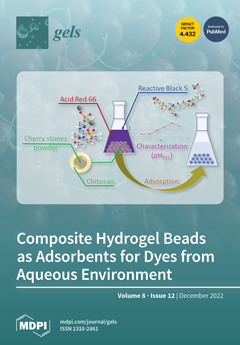Pectin was extracted from citrus pomelo waste, and the effects of calcium ions (Ca
2+) on the gelation and hydrogels properties were investigated over a pH range of 3.2–8 by using viscoelastic analysis. The gelatinization of Ca
2+-pectin was examined at
[...] Read more.
Pectin was extracted from citrus pomelo waste, and the effects of calcium ions (Ca
2+) on the gelation and hydrogels properties were investigated over a pH range of 3.2–8 by using viscoelastic analysis. The gelatinization of Ca
2+-pectin was examined at concentrations of 0.9, 1.8, 2.4, and 3.6 M of Ca
2+ in aqueous pectin solutions of 1%, 2%, 3%, and 4%. The gel transition of Ca
2+-pectin solution to hydrogels was determined by measuring the storage modulus (G’) and loss modulus (G”) under mechanical strain from 0.01 to 100%. In a hydrogel of 3% pectin at Ca
2+ = 2.4 M, as pH increased to 7, the G’ at 0.01 strain % was 3 × 10
4 Pa, and 3 × 10
3 Pa at pH 5, indicating that the crosslinking weakened at acidic pH. Due to the crosslinking between the calcium ions and the ionized carboxylic acid groups of pectin, the resulting hydrogel became stiff. When the mechanical strain % was in the range of 0.01–1%, G’ was unchanged and G” was an order of magnitude smaller than G’, indicating that the mechanical stress was relieved by the gel. In the range of 1–100%, the gel deformation progressed and both the moduli values were dropped. Collapse from the gel state to the solution state occurred at 1–10 strain %, but the softer hydrogels with G’ of 10
3 Pa had a larger strain % than the stiffer hydrogels with G’ of 10
4 Pa.
Full article






